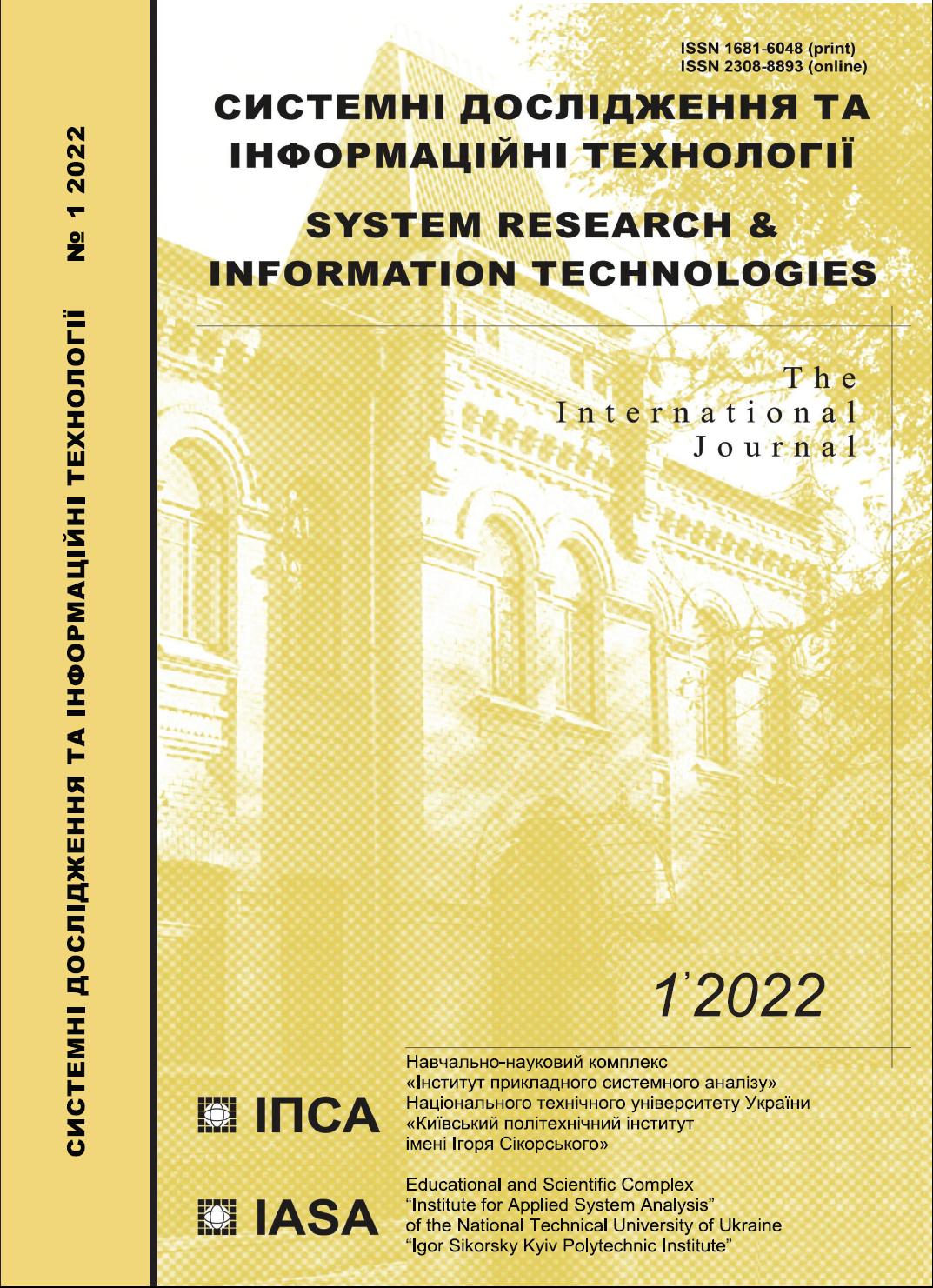System approach to the underground construction objects planning based on foresight and cognitive modelling methodologies
DOI:
https://doi.org/10.20535/SRIT.2308-8893.2022.1.01Keywords:
foresight, cognitive, impulse modelling, planning, scenarios, underground constructionAbstract
The system approach to the underground construction objects planning based on foresight and cognitive modeling methodologies is proposed. Using the foresight methodology allows with the help of expert estimation procedures to identify critical technologies and build alternatives of scenarios with quantitative characteristics. For the justified implementation of a particular scenario the cognitive modelling is used, which allows to build causal relationships based on knowledge and experience, understand and analyze the behaviour of a complex system for a strategic perspective with a large number of interconnections and interdependencies. The suggested system approach allows planning of underground objects on the basis of reasonable scenarios selection and justification of their creation priority.
References
World Urbanization Prospects 2018: Highlights. United Nations. New York, 2019. Available: https://population.un.org/wup/Publications/Files/WUP2018-Highlights.pdf
I. Vähäaho, “Underground space planning in Helsinki”, Journal of Rock Mechanics and Geotechnical Engineering, 6, pp. 387–398, 2014. Available: https://doi.org/10.1016/j.jrmge.2014.05.005
C.L. Owen and C. Bezerra, “Evolutionary Structured Planning. A Computer-Supported Methodology for the Conceptual Planning Process”, in JS Gero (ed.) Artificial Intelligence in Design’00. Dordrecht: Kluwer Academic Publishers, 2000, pp. 287–307.
A.N. Levchenko, “About a new direction of scientific research in construction geotechnology”, Mining information and analytical bulletin (scientific and technical journal), no. 2, pp. 15–21, 2007.
P. Saługa, Ocena ekonomiczna projektów i analiza ryzyka w górnictwie [Economic Evaluation and Risk Analysis of Mineral Projects]. Studia, Rozprawy, Monografie, nr 152, Wyd. IGSMiE PAN, Kraków, 2009.
B.A. Kartosia, “Mastering the underground space of large cities. New Trends”, Mining Information and Analytical Bulletin (scientific and technical magazine), “Construction and Architecture”, pp. 615–628, 2015.
B. Kartozia, Fundamentals of Underground Space Development, (in Russian). M.: Press Department of Moscow State University for the Humanities, 2009.
B.A. Kartosia, “The development of the underground space is a global problem of science, production and higher mountain education”, Materials conf. prospects for the development of underground space, pp. 12–26, 2010.
R. Sterling et al., “Sustainability issues for underground spaces in urban areas”, Proceedings of ICE. Urban Design and Planning, vol. 165, issue 4, pp. 241–254, 2012. Available: https://doi.org/10.1680/udap.10.00020
C.L. Owen and C. Bezerra, “Evolutionary Structured Planning. A Computer-Supported Methodology for the Conceptual Planning Process”, in JS Gero (ed.) Artificial Intelligence in Design’00. Dordrecht: Kluwer Academic Publishers, 2000, pp. 287–307.
P.H. Gilbert et al., Underground Engineering for Sustainble Urban Development. Washington: The National Academies Press, 2013. doi: https://doi.org/10.17226/ 14670
V.I. Resin and Yu.S. Popkov, Large cities development in conditions of transition economy (system approach). Moscow: Knizhnyi dom “LIBROKOM”, 2013.
N. Pankratova, I. Savchenko, H. Haiko, and V. Kravets, “System approach to planning urban underground development”, J. Information Content and Processing, vol. 6, no. 1, pp. 3–17, 2019.
M.Z. Zgurovsky and V.A. Pankratov, “Strategy of innovative development of the region on the basis of the foresight and cognitive modeling methodologies synthesis”, (in Russian), Systematic research and information technologies, no. 2, pp. 7–17, 2014.
P.A. Mikhnenko, “Dynamic modification of SWOT analysis”, Economic analysis: theory and practice, 18 (417), pp. 60–68, 2015.
Alptekin Nesrin, “Integration of SWOT Analysis and TOPSIS Method In Strategic Decision Making Process”, The Macrotheme Review, 2 (7), 2013.
García-Cascale M. Socorro and Lamata M. Teresa, “On rank reversal and TOPSIS method”, Mathematical and Computer Modelling, vol. 56, no. 5–6, pp. 123–132, 2012.
Mardani Abbas, Zavadskas Edmundas, Govindan Kannan, Senin Aslan, and Jusoh Ahmad , “VIKOR Technique: A Systematic Review of the State of the Art Literature on Methodologies and Applications”, Sustainability, 8 (37), pp. 1–38, 2016.
K. Gopalakrishnan and V. Vijayalakshmi, “Using Morphological Analysis for Innovation and Resource and Development: An Invaluable Tool for Entrepreneurship”, Annual Research J. Symbiosis Centre for Management Studies, Pune, vol. 2, issue 1, pp. 28–36, 2014.
T. Ritchey, “Futures Studies using Morphological Analysis”, Adapted from an article for the UN University Millennium Project: Futures Research Methodology Series, 2005.
M.Z. Zgurovsky and N.D. Pankratova, System analysis: Theory and Applications. New York: Springer, Berlin Heidelberg, 2007.
Weimer-Jehle Wolfgang, “Cross-impact balances: A system-theoretical approach to cross-impact”, Technological Forecasting & Social Change, 73, pp. 334–361, 2006.
V. Pankratov, “Development of the approach to formalization of vector’s indicators of sustainable development”, J. Information Technologies & Knowledge. ITHEA. SOFIA, vol. 8, no. 3, pp. 203–211, 2014.
Innovative development of socio-economic systems based on foresight and cognitive modelling methodologies, (in russian); in editors G.V. Gorelova, N.D. Pankratova. Kiev: Nauk. Dumka, 2015.
V. Kulba, D.A. Kononov, S.S. Kovalevsky, S.A. Kosyachenko, R.M. Nizhegorodtsev, and I.V. Chernov, Scenario analysis of the dynamics of behavior of socio-economic systems, (in russian). M.: IPU RAS, 2002.
V.I. Maksimov, “Cognitive technology – from ignorance to understanding.1st work”, Cognitive analysis and management of the development of situations, (CASC’2001), 1, pp.4–18, 2001.
R.H. Atkin, “Combinatorial Connectivies in Social Systems. An Application of Simplicial Complex Structures to the Study of Large Organisations’”, Interdisciplinary Systems Research, 1997.
J. Casti, Connectivity, Complexity, and Catastrophe in Large-scale Systems. Chichester – New York – Brisbane – Toronto: A Wiley – Interscience Publication International Institute for Applied Systems Analysis. JOHN WILEY and SONS, 1979.
F. Roberts, Graph Theory and its Applications to Problems of Society. Philadelphia: Society for Industrial and Applied Mathematics, 1978.
Program for cognitive modeling and analysis of socio-economic systems at the regional level. Certificate of state registration of computer programs N2018661, 2018.

